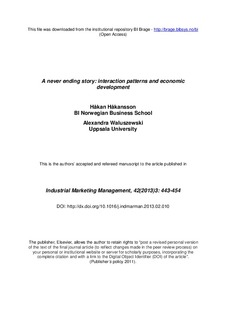| dc.description.abstract | Industrial marketing and purchasing is an interesting phenomenon. On the surface it appears as very mundane, a simple day-to-day activity performed by purchasers, sales personnel, and technical specialists; i.e. most often by professions representing ‘middle management’. As such, it is not surrounded with any of the greater prestige ascribed to more hyped business activities, such as financing and strategy. Furthermore, industrial marketing and purchasing is seldom recognised as being of any greater importance for society at large. In policy circles, for example the UN, OECD and EU, where they stress the importance of innovation, productivity and growth, industrial marketing and purchasing is rarely mentioned as a related phenomenon .
Behind the scenes, however, an empirical, much more challenging view is outlined. When the content and the effects of industrial marketing and purchasing processes are scrutinised empirically, these activities appear as perhaps the most important source for business development, industrial renewal, efficiency and innovation. From this perspective, industrial marketing and purchasing seems to be a critical phenomenon for creating prosperity for both companies and communities and for general economic growth. It is this role of industrial marketing and purchasing that we highlight and discuss in this article. Based on extensive empirical research results, we argue that interaction is the main ingredient in these processes. This implies that the supplier-customer interaction has a central development function for efficiency and innovativeness, for companies as well as for the economy at large. Thus, there is a strong need to include and consider this key engine for dynamics (and its role in developing materialised structures as well as ideas) in any theoretical study of economic development. | no_NO |
